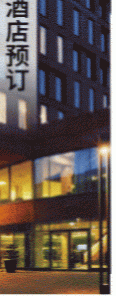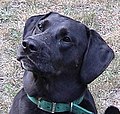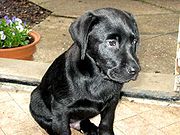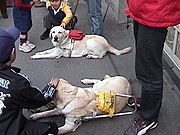|
  
- 积分
- 36813
- 威望
- 6954
- 金钱
- 2
- 阅读权限
- 110
- 性别
- 男
- 来自
- 網絡猩球
- 在线时间
- 3761 小时
|
28#
 发表于 2007-1-5 18:40
发表于 2007-1-5 18:40
| 只看该作者

我喜欢的品种,Doberman Pinscher,多勃曼或者叫杜宾
可惜没找到中文的,这个页面里的都不漂亮,俱乐部比赛用的会很好看。 Doberman PinscherFrom Wikipedia, the free encyclopedia(Redirected from Dobermann)
Jump to: navigation, search
For the movie called "Dobermann", see Dobermann (film).
Doberman Pinscher
Doberman with docked tail and cropped ears.Alternative namesDobermannCountry of originGermanyCommon nicknamesDobe
DobieClassification and breed standardsFCI:Group 2 Section 1 #143StdsAKC:WorkingStdsANKC:Group 6 (Utility)StdsCKC:Group 3 - Working DogsStdsKC (UK):WorkingStdsNZKC:UtilityStdsUKC:Guardian DogsStdsThe Doberman Pinscher (alternatively spelled Dobermann in many countries) or Doberman is a breed of domestic dog. Doberman Pinschers are commonly used as guard dogs, watch dogs, or police dogs. In many countries, Doberman Pinschers are one of the most recognizable breeds, in part because of their actual roles in society, and in part because of media stereotyping (see temperament).
[edit] AppearanceAccording to the AKC breed standard, the shoulder height of a Doberman Pinscher bitch is between 24 to 26 inches, whereas the male stands between 26 to 28 inches at the shoulder. The Fédération Cynologique Internationale standard is slightly different and is followed by most countries. A male Doberman Pinscher should stand 26.5 to 28 inches (68 to 72 cm) and weigh between 89 to 100 pounds (40 to 45 kg). A female should stand 24.5 inches to 27 inches (63 to 68 cm) and weigh between 71 to 78 pounds (32 to 35 kg).
Doberman Pinschers typically have a deep, broad chest, and a powerful, muscular body of medium size. However, in recent years some breeders have primarily bred, shown, and sold a slimmer or more sleek-looking Doberman Pinscher. This has become a popular body type among many owners, especially those who want to show their Doberman Pinschers competitively. The traditional body type is still more desirable to many casual owners and to those who want the dog for protection. Furthermore, despite the "ideal" standards, it is impossible to have complete control over the size and weight of dogs. Generally speaking, show animals must fall within the ideal range of both size and weight (for that country's breed standard), but it is not unusual to find male Dobes weighing over 100 pounds or females that are also larger than called for by the breed standards. Larger sizes might lead to additional health problems, although those who are looking for a Doberman Pinscher to provide personal protection or for use in police agencies or the military generally seek out the larger examples and some breeders create specific breeding pairs in the hope of getting a litter of larger dogs.
[edit] Color 
Young Blue Female.
Most people know the typical black color of a Doberman Pinscher. However, two different color genes exist in the Doberman, one for black (B) and one for color dilution (D), which provides for four different color phenotypes: black, red, blue, and fawn.color.chart.5.html The traditional and most common color occurs when both the color and dilution genes have at least one dominant allele (BB, Bb, or bB and DD, Dd, or dD), and is commonly referred to as black or black and rust (also called black and tan). The most common color variation occurs when the black gene has two recessive alleles (bb) but where the dilution gene has at least one dominant allele (DD, Dd, or dD), which produces what is called a red or red and rust Doberman Pinscher in America and a "brown" Dobermann in the rest of the world, which is a deep reddish-brown with rust markings.
The remaining two colors, blue and fawn, are controlled by the color dilution gene. In the case of the blue Doberman, the color gene has at least one dominant allele (BB, Bb, or bB), but the dilution gene has both recessive alleles (dd). The fawn is the least common colour and occurs when both the color and dilution genes have two recessive alleles (bb and dd). Thus, the blue color is a diluted black, and the fawn color is a diluted red. Blue and fawn Doberman Pinschers often suffer from a condition called Color Dilution Alopecia, which can result in severe hair loss.
In 1976, a "white" Doberman Pinscher famale was born,[1] and was subsequently bred to her son, who was also bred to his litter sisters. This tight inbreeding continued for some time to allow the breeders to "fix" the mutation, which has been widely marketed. Doberman Pinschers of this color possess a genetic mutation, which prevents its pigment proteins from being manufactured, regardless of the genotypes of either of the two color genes; that is, it is an albino. Though some potential Doberman Pinscher owners find the color attractive, albino Doberman Pinschers, like albinos of other species, face increased risk of cancer and other diseases and because of this and because of abnormal development of the retina, should avoid sun exposure as much as possible. The popularity of the "white" Doberman Pinscher has decreased dramatically as these risks have become known, with many people have called for an end to the breeding and marketing of the white Doberman Pinscher because they perceive it as cruelty to the animal. Some countries have made the purposeful breeding of the white Doberman illegal, but breeders who care and take note of the ancestors can avoid breeding albinos as they are all descended from the original famale. A list of every descendent of the original albino-producing dogs is available so that breeders can avoid producing this mutant dog.[2] The American Kennel Club registers but disqualifies albino Doberman Pinschers, and the Doberman Pinscher Club of America has actively worked to discourage breeding to obtain albino Doberman Pinschers.[3]
[url=][/url]
[edit] TailsAlthough the Doberman Pinscher is most commonly seen with its traditional short tail, it is actually born with a tail that is longer than many breeds. Typically, a Doberman Pinscher undergoes docking, a procedure in which the majority of its tail is surgically removed within days of its birth. The rationale being that it completes the sleek "look" that the dog is supposed to have, since it was the way Louis Dobermann had originally envisioned the dog.
Few potential owners have a choice on the length of their Doberman Pinscher's tail, docking is normally done soon after the dog's birth, which means that the breeder nearly always makes the decision, before their dogs are even put on the market.
[edit] Ears 
Doberman with natural ears.
Doberman Pinscher ear cropping is usually done between 7 and 9 weeks of age. It is something that should be taken care of while still in the breeder's care, before the puppy goes home with its new owners. Cropping done after 12 weeks has a high rate of failure in getting the ears to stand. Some Doberman Pinscher owners prefer not to have their pet's ears cropped because the procedure may be painful for the animal. The process involves trimming off part of the animal's ears and propping them up with posts and tape bandages, which allows the cartilage to develop into an upright position as the puppy grows. The puppy will still have the ability to lay the ears back or down. The process of posting the ears generally takes about a month, but longer show crops can take several months.
While there have been no studies that have examined cropped vs non-cropped Doberman Pinschers, it is believed that cropping dramatically reduces the occurrence of ear infections and hematomas (blood blisters caused by damage to the ear tips, commonly from hard shaking of the head).
The traditional Doberman has always been the one that has had both procedures. In some countries, docking and cropping are now illegal, but in some breed shows Doberman Pinschers are allowed to compete only if they have the traditional look.
[edit] Ear TapingThe ear taping occurs after the initial sugery has been done. It is recommended to let all cuts and scabs heal before beginning the taping process. Anti-bacterial powder used for rashes such as Zeasorb works well to reduce itchiness for the dog and Polysporin helps to reduce scaring. As stated above, the taping of the ears can take up to seven months to do. Each dog is different as there are many variables involved in the ear taping process. The best way to tell if a Doberman Pinscher's ears are done are by trial and error. If the ears remain upright after several days, the ears are done. If they flop or start to droop, they are not. Doberman Pinscher ears should not remain taped for more than 10 days without a 24 hour break to air out.
Ear taping is done with posts and tape. Posts keep the ears straight in the upright position allowing them to grow and strengthen the cartilage. The best posts for taping Doberman ears are the cardboard pieces used in tampons. These provide a nice round "bell" like look to the ear due to their long cylindrical shape. The typical tape used for Doberman Pinschers would be an athletic tape with a strong adhesive such as Johnson and Johnson Zonas or Leukotape P.
There are many variables involved such as crop size, infection, healing, post choice, tape choice, time, etc. Never attempt to tape a Doberman Pinscher's ears without consulting or receiving instruction from a professional breeder. Registered breeders can be found on both the American and Canadian Doberman Pinscher Club websites. Doberman Pinscher Club of America Doberman Pinscher Club of Canada
Pictures and in-depth instructions can be found at Carosel Kennel
[url=][/url]
[edit] TemperamentThe Doberman Pinscher is often used as a protection dog, due to its intelligence, loyalty, and ability to physically challenge human aggressors. Doberman Pinschers are even now, and once more extensively, used in police work and in the military. The breed was used extensively by the U.S. Marines in World War II, and 25 Marine War Dogs died in the Battle of Guam in 1944: there is a memorial on Guam in honor of these Doberman Pinschers.[4] In these roles, they inspire fear. They are often stereotyped in such roles in movies (where they are trained to exhibit seemingly "aggressive" behavior), and video games, consequently many people are afraid of the breed. A related problem is the misunderstanding of their legitimate roles; because guard dogs are trained to neutralize unwelcome intruders, many people mistakenly believe that Doberman Pinschers are vicious.
However, Doberman Pinschers are, in general, a gentle, loyal, loving, and highly intelligent breed. Although there is variation in temperament, a typical pet Doberman attacks only if it believes that it, its property, or its family are in danger. According to a study done by the U. S. Centers for Disease Control, the Doberman Pinscher is involved in human dog bite-related incidents less frequently than many other dog breeds. Those familiar with the breed consider well-bred and properly socialized Doberman Pinschers to be excellent pets and companions, suitable for families with other dog breeds, excellent with young children, and even cats.
[edit] HealthAn average, healthy Doberman Pinscher is expected to live close to 12 years, with a majority of Doberman Pinschers dying between age 11 and 13. Common health problems are dilated cardiomyopathy, wobbler disease, von Willebrand's disease (a bleeding disorder that can be tested for genetically), hypothyroidism, cancer, and in the dilute colors (blues and fawns), alopecia (see follicular dysplasia).
[edit] HistoryDoberman Pinschers were first bred in Germany around 1890 by Karl Friedrich Louis Dobermann. After his death in 1894, the Germans named the breed Dobermann-pinscher in his honor, but a half century later dropped the pinscher on the grounds that this German word for terrier was no longer appropriate. The British did the same thing a few years later. He was a tax collector who frequently traveled through many bandit-infested areas, and needed a protection dog to guard him in any situation that might arise. He set out to breed a new type of dog that, in his opinion, would be the perfect combination of strength, loyalty, intelligence, and ferocity. (He also worked with dogs as a second job, giving him access to dogs for breeding.) Later, Otto Goeller and Philip Gruening continued to develop the breed.
The breed is believed to have been created from several different breeds of dogs that had the characteristics that Dobermann was looking for, including the Pinscher, the Beauceron, the Rottweiler, the Thuringian Shepherd Dog, the black Greyhound, the Great Dane, the Weimaraner, the German Shorthaired Pointer, and the German Shepherd Dog. The exact ratios of mixing, and even the exact breeds that were used, remains uncertain to this day, although many experts believe that the Doberman Pinscher is a combination of at least four of these breeds. The single exception is the documented cross with the Greyhound. It is also widely believed that the German Shepherd gene pool was the single largest contributor to the Doberman breed. |
|














 发表于 2007-1-5 18:15
|
发表于 2007-1-5 18:15
| 




















